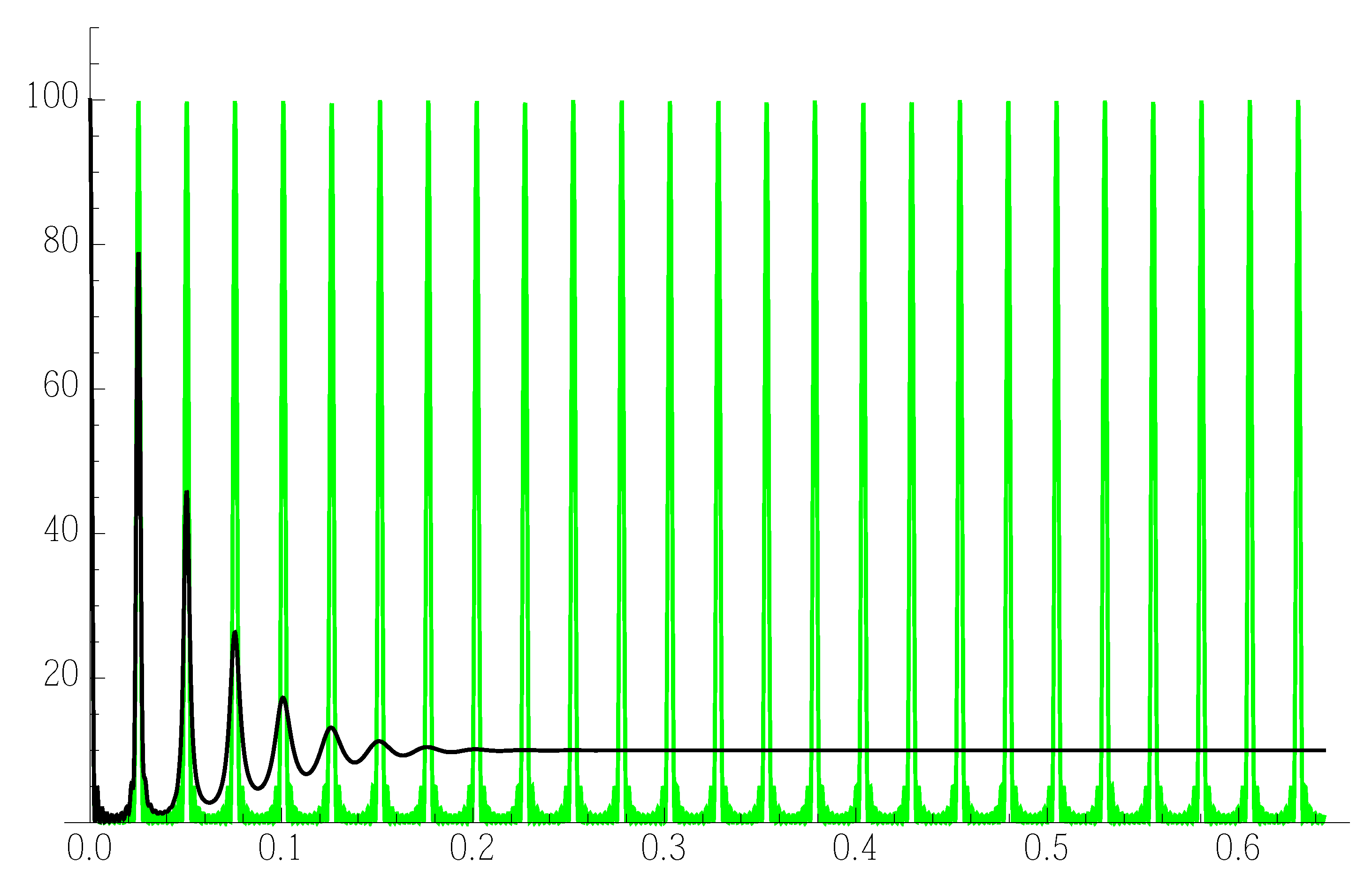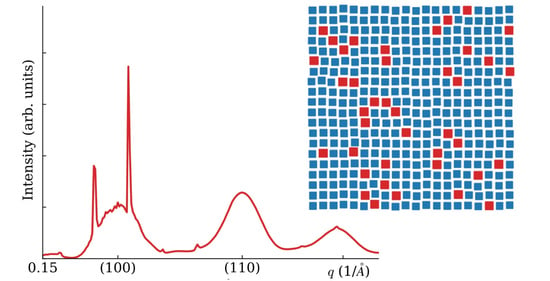Diffraction from Nanocrystal Superlattices
Abstract
:1. Introduction
2. Materials and Methods
3. Perfect Superlattice of Identical Nanocrystals
4. Superlattice of Not Identical Objects
4.1. 1D Superlattice
4.2. 2D and 3D Superlattices
4.3. Powder Diffraction Signal: Powder Average
5. Superlattice of Misaligned Objects
6. Example Calculations
6.1. 1D Chain of Parallel Planes with 1D Scattering
6.2. 1D, 2D and 3D SCs
6.3. Atomistic Simulations and 3D Scattering
7. Discussion
Author Contributions
Funding
Data Availability Statement
Conflicts of Interest
Abbreviations
| SC | Supercrystal (superlattice of nanocrystals) |
| SL | Superlattice whose nodes each contain a nanocrystal. |
| NC | A nanocrystal. Many (possibly imperfect) copies of an NC |
| are arranged onto an SL to form an SC. | |
| DSE | Debye scattering equation [21], Equations (30)–(32) |
| SDE | Size disorder effect. |
| ADE | Alignment disorder effect. |
| XRPD | X-ray powder diffraction. |
References
- Campione, S.; Steshenko, S.; Albani, M.; Capolino, F. Complex modes and effective refractive index in 3D periodic arrays of plasmonic nanospheres. Opt. Express 2011, 19, 26027–26043. [Google Scholar] [CrossRef] [PubMed]
- Talapin, D.V.; Lee, J.S.; Kovalenko, M.V.; Shevchenko, E.V. Prospects of colloidal nanocrystals for electronic and optoelectronic applications. Chem. Rev. 2010, 110, 389–458. [Google Scholar] [CrossRef] [PubMed]
- Yamada, Y.; Tsung, C.K.; Huang, W.; Huo, Z.; Habas, S.E.; Soejima, T.; Aliaga, C.E.; Somorjai, G.A.; Yang, P. Nanocrystal bilayer for tandem catalysis. Nat. Chem. 2011, 3, 372–376. [Google Scholar] [CrossRef] [PubMed] [Green Version]
- Murray, C.B.; Norris, D.J.; Bawendi, M.G. Synthesis and characterization of nearly monodisperse CdE (E = sulfur, selenium, tellurium) semiconductor nanocrystallites. J. Am. Chem. Soc. 1993, 115, 8706–8715. [Google Scholar] [CrossRef]
- Hines, M.A.; Guyot-Sionnest, P. Synthesis and Characterization of Strongly Luminescing ZnS-Capped CdSe Nanocrystals. J. Phys. Chem. 1996, 100, 468–471. [Google Scholar] [CrossRef]
- Boles, M.A.; Engel, M.; Talapin, D.V. Self-Assembly of Colloidal Nanocrystals: From Intricate Structures to Functional Materials. Chem. Rev. 2016, 116, 11220–11289. [Google Scholar] [CrossRef]
- Talapin, D.V.; Shevchenko, E.V.; Bodnarchuk, M.I.; Ye, X.; Chen, J.; Murray, C.B. Quasicrystalline order in self-assembled binary nanoparticle superlattices. Nature 2009, 461, 964–967. [Google Scholar] [CrossRef]
- Santos, P.J.; Gabrys, P.A.; Zornberg, L.Z.; Lee, M.S.; Macfarlane, R.J. Macroscopic materials assembled from nanoparticle superlattices. Nature 2021, 591, 586–591. [Google Scholar] [CrossRef]
- Li, T.; Senesi, A.J.; Lee, B. Small Angle X-ray Scattering for Nanoparticle Research. Chem. Rev. 2016, 116, 11128–11180. [Google Scholar] [CrossRef]
- Jiang, Z.; Lee, B. Recent advances in small angle X-ray scattering for superlattice study. Appl. Phys. Rev. 2021, 8, 011305. [Google Scholar] [CrossRef]
- Glatter, O.; Kratky, O. (Eds.) Small-Angle X-ray Scattering; Academic Press: New York, NY, USA, 1982. [Google Scholar]
- Senesi, A.J.; Lee, B. Small-angle scattering of particle assemblies. J. Appl. Crystallogr. 2015, 48, 1172–1182. [Google Scholar] [CrossRef]
- Smith, D.K.; Goodfellow, B.; Smilgies, D.M.; Korgel, B.A. Self-Assembled Simple Hexagonal AB2 Binary Nanocrystal Superlattices: SEM, GISAXS, and Defects. J. Am. Chem. Soc. 2009, 131, 3281–3290. [Google Scholar] [CrossRef] [PubMed]
- Cherniukh, I.; Rainò, G.; Stöferle, T.; Burian, M.; Travesset, A.; Naumenko, D.; Amenitsch, H.; Erni, R.; Mahrt, R.F.; Bodnarchuk, M.I.; et al. Perovskite-type superlattices from lead halide perovskite nanocubes. Nature 2021, 593, 535–542. [Google Scholar] [CrossRef] [PubMed]
- Bertolotti, F.; Vivani, A.; Ferri, F.; Anzini, P.; Cervellino, A.; Bodnarchuk, M.I.; Nedelcu, G.; Bernasconi, C.; Kovalenko, M.V.; Masciocchi, N.; et al. Size Segregation and Atomic Structural Coherence in Spontaneous Assemblies of Colloidal Cesium Lead Halide Nanocrystals. Chem. Mater. 2022, 34, 594–608. [Google Scholar] [CrossRef]
- Cervellino, A.; Frison, R.; Bertolotti, F.; Guagliardi, A. DEBUSSY 2.0: The new release of a Debye user system for nanocrystalline and/or disordered materials. J. Appl. Crystallogr. 2015, 48, 2026–2032. [Google Scholar] [CrossRef] [Green Version]
- Frison, R.; Chodkiewicz, M.; Weber, T.; Ahrenberg, L.; Bürgi, H.B. ZODS—Zurich Oak Ridge Disorder Simulation; University of Zurich: Zurich, Switzerland, 2016. [Google Scholar]
- Friedrich, W.; Knipping, P.; Laue, M.V. Interferenz-Erscheinungen bei Röntgenstrahlen. Sitzungsberichte Math. Phys. Kl KB Akad. Wiss. München 1912, 1912, 303–327. [Google Scholar]
- Laue, M.V. Eine quantitative Prüfung der Theorie für die Interferenz-Erscheinungen bei Röntgenstrahlen. Sitzungsberichte Math. Phys. Kl KB Akad. Wiss. München 1912, 1912, 363–378. [Google Scholar]
- Weisstein, E. From MathWorld—A Wolfram Web Resource: Chebyshev Polynomial of the Second Kind. Available online: https://mathworld.wolfram.com/ChebyshevPolynomialoftheSecondKind.html (accessed on 7 April 2022).
- Debye, P. Zerstreuung von Röntgenstrahlen. Ann. Phys. 1915, 46, 809–823. [Google Scholar] [CrossRef] [Green Version]
- Cervellino, A.; Maspero, A.; Masciocchi, N.; Guagliardi, A. From Paracrystalline Ru(CO)4 1D Polymer to Nanosized Ruthenium Metal: A Case of Study through Total Scattering Analysis. Cryst. Growth Des. 2012, 12, 3631–3637. [Google Scholar] [CrossRef]
- Hosemann, R.; Bagchi, S. Direct Analysis of Diffraction by Matter; North-Holland Publishing Company: Amsterdam, The Netherlands, 1962. [Google Scholar]
- Welberry, T. Diffuse X-ray Scattering and Models of Disorder; Oxford University Press: Oxford, UK, 2004. [Google Scholar]
- Bragg, W.H.; Bragg, W.L. X-rays and Crystal Structure; G. Bell and Sons, Ltd.: London, UK, 1915. [Google Scholar]
- Pabst, G.; Koschuch, R.; Pozo-Navas, B.; Rappolt, M.; Lohner, K.; Laggner, P. Structural analysis of weakly ordered membrane stacks. J. Appl. Crystallogr. 2003, 36, 1378–1388. [Google Scholar] [CrossRef]
- Caillé, A. Remarques sur la diffusion des rayons X dans les smectiques. C. R. Hebd. Séances L’Académie Sci. Ser. B 1972, 274, 891–893. [Google Scholar]
- Hamley, I.W. Diffuse scattering from lamellar structures. Soft Matter 2022, 18, 711–721. [Google Scholar] [CrossRef] [PubMed]









Publisher’s Note: MDPI stays neutral with regard to jurisdictional claims in published maps and institutional affiliations. |
© 2022 by the authors. Licensee MDPI, Basel, Switzerland. This article is an open access article distributed under the terms and conditions of the Creative Commons Attribution (CC BY) license (https://creativecommons.org/licenses/by/4.0/).
Share and Cite
Cervellino, A.; Frison, R. Diffraction from Nanocrystal Superlattices. Nanomaterials 2022, 12, 1781. https://doi.org/10.3390/nano12101781
Cervellino A, Frison R. Diffraction from Nanocrystal Superlattices. Nanomaterials. 2022; 12(10):1781. https://doi.org/10.3390/nano12101781
Chicago/Turabian StyleCervellino, Antonio, and Ruggero Frison. 2022. "Diffraction from Nanocrystal Superlattices" Nanomaterials 12, no. 10: 1781. https://doi.org/10.3390/nano12101781
APA StyleCervellino, A., & Frison, R. (2022). Diffraction from Nanocrystal Superlattices. Nanomaterials, 12(10), 1781. https://doi.org/10.3390/nano12101781






